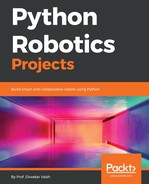OK, that's a lot of theory, so now let's fire up one of our motors via Raspberry Pi. To do that, go ahead and connect the motor and the motor driver as shown:

Now, once you are done with it, let's upload the code and see what happens:
import RPi.GPIO as GPIO
from time import sleep
GPIO.setmode(GPIO.BCM)
Motor1R = 20
Motor1L = 21
GPIO.setup(Motor1R,GPIO.OUT)
GPIO.setup(Motor1L,GPIO.OUT)
GPIO.output(Motor1R,GPIO.HIGH)
GPIO.output(Motor1L,GPIO.LOW)
sleep(5)
GPIO.output(Motor1R,GPIO.LOW)
GPIO.output(Motor1L,GPIO.HIGH)
sleep(5)
GPIO.cleanup()
Now, let's understand the code a bit:
Motor1R = 20
Motor1L = 21
Pin number 20 is connected to IN 1 of the motor driver. For convenience, we have changed motor 1 right to Motor1R; in reality, the motor can spin in any direction but we have just written this for convenience and understanding. Similarly, we have done this for Motor1L as well. This is connected to IN 2, hence this will lead to the motor spinning in the other direction:
GPIO.output(Motor1R,GPIO.HIGH)
GPIO.output(Motor1L,GPIO.LOW)
Here, we are making the Motor1R or the pin number 20 high, which means that the input motor driver is getting is:
| Motor | Pin | Input | State |
| Motor 1R | Pin number 20 of Raspberry Pi | IN 1 | HIGH |
| Motor 1L | Pin number 21 of Raspberry Pi | IN 2 | LOW |
Now, after a delay of 5 seconds, the following code will run, which will change the state of the pins as depicted in the below table:
GPIO.output(Motor1R,GPIO.LOW)
GPIO.output(Motor1L,GPIO.HIGH)
| Motor | Pin | Input | State |
| Motor 1R | Pin number 20 of Raspberry Pi | IN 1 | LOW |
| Motor 1L | Pin number 21 of Raspberry Pi | IN 2 | HIGH |
Now, let's see what happens once we run it. The motor will spin firstly in one direction and then it will go in the other direction. The code is very straightforward and I don't think there is any need for explanation. All we are doing here is simply turning either of the two GPIOs connected to the motor driver on and off. Once the input IN 1 of the motor driver is activated, a part of the H-bridge is switched on, causing the motor to spin in one direction. Whenever the IN 2 of the motor driver is high, then the opposite part of H-bridge is turned on, causing the polarity at the output end of the motor driver to change, and hence the motor turns in the other direction.
